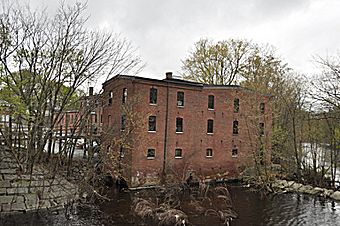Bemis Mill facts for kids
Quick facts for kids |
|
|
Bemis Mill
|
|
 |
|
| Location | Newton, Massachusetts |
|---|---|
| Built | 1845 |
| MPS | Newton MRA |
| NRHP reference No. | 86001773 |
| Added to NRHP | September 4, 1986 |
The Bemis Mill is an old building in Newton, Massachusetts. It used to be a factory but is now an office building called the Meredith Building. This building is important because it's one of the oldest factories left in the city. It also has special parts that show how it used water power long ago. The Bemis Mill was added to the National Register of Historic Places on September 4, 1986.
Contents
Exploring the Bemis Mill Building
The Bemis Mill is a three-story building. It is made from handmade bricks. The building has an L-shape. The part of the "L" facing the river was built first. The other part was added before 1875.
The side of the building facing the Charles River has a strong foundation. This foundation is made of large granite blocks. It has two arched openings. These openings let water in to power the mill. Today, the old water channels are gone. Only small parts of the dam remain.
A Look at the Mill's Design
The building's design shows how factories were built long ago. Its strong brick walls have stood for many years. The L-shape allowed for future growth. The granite foundation was key for water power. These features make the Bemis Mill a unique historical site.
The Long History of Bemis Mill
The land where Bemis Mill stands has been used for factories since the 1700s. A dam was built across the river by 1778. David Bemis built a paper mill here in 1779. It might have been on the site of an even older mill.
David Bemis also built mills in Watertown. These mills later became a successful textile factory. The paper mill at this site closed in 1821. It was then changed to make textiles.
Water Power and New Ideas
In 1822, a company from Waltham offered money. They wanted Seth Bemis to lower his dam. This was because the water from his dam was backing up to their factory. Around this time, a special "rolling dam" technology was added. This helped control the water flow. A new building might have been built then too. Parts of this old system are still in the basement. This type of system was very rare.
From Dyes to Office Space
The Bemis family used the mill until the 1840s. They made dyes here. In 1847, William Freeman bought this mill. His son bought the mills in Watertown. They both worked for the Aetna Manufacturing Company. This company kept making dyes here until 1870.
After 1870, the building changed again. It started to provide power to the mills across the river. A belt passed through a slot in the building. This belt went across the river to power other factories. Textile making slowed down around 1920. After that, the building made fabrics for cars for a while. Finally, it became the office building we see today.



